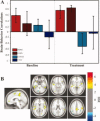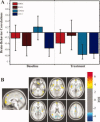Distinct functional networks associated with improvement of affective symptoms and cognitive function during citalopram treatment in geriatric depression
- PMID: 20886575
- PMCID: PMC3021765
- DOI: 10.1002/hbm.21135
Distinct functional networks associated with improvement of affective symptoms and cognitive function during citalopram treatment in geriatric depression
Abstract
Variability in the affective and cognitive symptom response to antidepressant treatment has been observed in geriatric depression. The underlying neural circuitry is poorly understood. This study evaluated the cerebral glucose metabolic effects of citalopram treatment and applied multivariate, functional connectivity analyses to identify brain networks associated with improvements in affective symptoms and cognitive function. Sixteen geriatric depressed patients underwent resting positron emission tomography (PET) studies of cerebral glucose metabolism and assessment of affective symptoms and cognitive function before and after 8 weeks of selective serotonin reuptake inhibitor treatment (citalopram). Voxel-wise analyses of the normalized glucose metabolic data showed decreased cerebral metabolism during citalopram treatment in the anterior cingulate gyrus, middle temporal gyrus, precuneus, amygdala, and parahippocampal gyrus. Increased metabolism was observed in the putamen, occipital cortex, and cerebellum. Functional connectivity analyses revealed two networks which were uniquely associated with improvement of affective symptoms and cognitive function during treatment. A subcortical-limbic-frontal network was associated with improvement in affect (depression and anxiety), while a medial temporal-parietal-frontal network was associated with improvement in cognition (immediate verbal learning/memory and verbal fluency). The regions that comprise the cognitive network overlap with the regions that are affected in Alzheimer's dementia. Thus, alterations in specific brain networks associated with improvement of affective symptoms and cognitive function are observed during citalopram treatment in geriatric depression.
Copyright © 2010 Wiley-Liss, Inc.
Figures
Similar articles
-
Serotonin modulation of cerebral glucose metabolism in depressed older adults.Biol Psychiatry. 2009 Aug 1;66(3):259-66. doi: 10.1016/j.biopsych.2009.02.012. Epub 2009 Apr 15. Biol Psychiatry. 2009. PMID: 19368900 Free PMC article. Clinical Trial.
-
Structural imaging in late-life depression: association with mood and cognitive responses to antidepressant treatment.Am J Geriatr Psychiatry. 2015 Jan;23(1):4-12. doi: 10.1016/j.jagp.2013.10.001. Epub 2013 Oct 5. Am J Geriatr Psychiatry. 2015. PMID: 24238925 Free PMC article. Clinical Trial.
-
The relationship between the acute cerebral metabolic response to citalopram and chronic citalopram treatment outcome.Am J Geriatr Psychiatry. 2011 Jan;19(1):53-63. doi: 10.1097/jgp.0b013e3181eafde4. Am J Geriatr Psychiatry. 2011. PMID: 21218565 Free PMC article.
-
Serotonin transporter occupancy and the functional neuroanatomic effects of citalopram in geriatric depression.Am J Geriatr Psychiatry. 2011 Dec;19(12):1016-25. doi: 10.1097/JGP.0b013e318227f83f. Am J Geriatr Psychiatry. 2011. PMID: 21841458 Free PMC article. Clinical Trial.
-
Serotonin modulation of cerebral glucose metabolism measured with positron emission tomography (PET) in human subjects.Synapse. 2002 Aug;45(2):105-12. doi: 10.1002/syn.10088. Synapse. 2002. PMID: 12112403 Clinical Trial.
Cited by
-
Electrical Stimulation Normalizes c-Fos Expression in the Deep Cerebellar Nuclei of Depressive-like Rats: Implication of Antidepressant Activity.Cerebellum. 2017 Apr;16(2):398-410. doi: 10.1007/s12311-016-0812-y. Cerebellum. 2017. PMID: 27435250
-
Treatment-related alteration of cortisol predicts change in neuropsychological function during acute treatment of late-life anxiety disorder.Int J Geriatr Psychiatry. 2012 May;27(5):454-62. doi: 10.1002/gps.2732. Epub 2011 Jun 17. Int J Geriatr Psychiatry. 2012. PMID: 21681817 Free PMC article. Clinical Trial.
-
Recent advances in neuroimaging biomarkers in geriatric psychiatry.Curr Psychiatry Rep. 2013 Jun;15(6):360. doi: 10.1007/s11920-013-0360-9. Curr Psychiatry Rep. 2013. PMID: 23636984 Free PMC article.
-
Insights into Intrinsic Brain Networks based on Graph Theory and PET in right- compared to left-sided Temporal Lobe Epilepsy.Sci Rep. 2016 Jun 28;6:28513. doi: 10.1038/srep28513. Sci Rep. 2016. PMID: 27349503 Free PMC article.
-
Resting-state cortico-thalamic-striatal connectivity predicts response to dorsomedial prefrontal rTMS in major depressive disorder.Neuropsychopharmacology. 2014 Jan;39(2):488-98. doi: 10.1038/npp.2013.222. Epub 2013 Sep 13. Neuropsychopharmacology. 2014. PMID: 24150516 Free PMC article.
References
-
- Aizenstein HJ, Butters MA, Figurski JL, Stenger VA, Reynolds CF III, Carter CS ( 2005): Prefrontal and striatal activation during sequence learning in geriatric depression. Biol Psychiatry 58: 290–296. - PubMed
-
- Alexopoulos GS, Young RC, Meyers BS ( 1993): Geriatric depression: Age of onset and dementia. Biol Psychiatry 34: 141–145. - PubMed
-
- Alexopoulos GS, Meyers BS, Young RC, Kakuma T, Feder M, Einhorn A, Rosendahl E ( 1996): Recovery in geriatric depression. Arch Gen Psychiatry 53: 305–312. - PubMed
-
- Alexopoulos GS, Kiosses DN, Heo M, Murphy CF, Shanmugham B, Gunning‐Dixon F ( 2005): Executive dysfunction and the course of geriatric depression. Biol Psychiatry 58: 204–210. - PubMed
-
- Ashtari M, Greenwald BS, Kramer‐Ginsberg E, Hu J, Wu H, Patel M, Aupperle P, Pollack S ( 1999): Hippocampal/amygdala volumes in geriatric depression. Psychol Med 29: 629–638. - PubMed
Publication types
MeSH terms
Substances
Grants and funding
LinkOut - more resources
Full Text Sources
Medical





